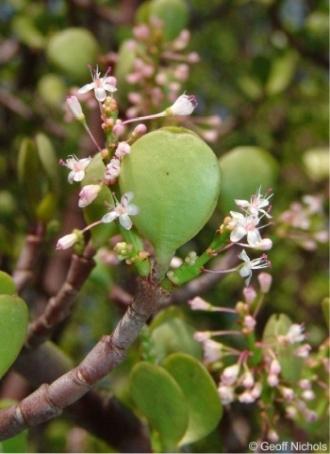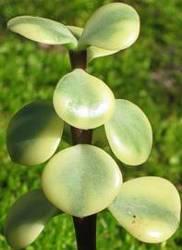Portulacaria afra
Portulacaria afra Jacq.
Family: Portulacaceae
Common names: Porkbush, Elephant's Food (English); Spekboom. Olifantskos (Afrikaans); iNtelezi, isiDondwane, isAmbilane, iNdibili, isiCococo (isiZulu); iGqwanitsha (isiXhosa).
Introduction
Portulacaria afra or Porkbush is a popular succulent garden plant in use around the world and is often used for bonsai. It has now been shown to be effective in carbon sequestration (binding atmospheric carbon which is responsible for climate change), in semi-arid landscapes and thicket vegetation it is also being used for restoration purposes.

Description
Description
The Porkbush is an attractive, evergreen succulent shrub or small tree that can reach 2 - 5 m in height, although usually around 1.5 - 2 m in a garden situation. It has small round succulent leaves and red stems. Small star-shaped pink flowers are borne en masse from late winter to spring although flowering in cultivation is often erratic. They are a rich source of nectar for many insects, which in-turn attracts insectivorous birds.

Conservation Status
Status
Portulacaria afra is listed in the National Red List as Least Concern (LC) which indicates that it is not threatened in its natural habitat.
Distribution and habitat
Distribution description
It is found in warm situations on rocky slopes in succulent karoo scrub, thicket, bushveld and dry river valleys in the eastern parts of South Africa from the Eastern Cape northwards into KwaZulu-Natal, Swaziland, Mpumalanga and the Limpopo Province as well as Mozambique.
Derivation of name and historical aspects
History
The name Portulacaria is composed of Portulaca + aria suggesting a similarity to the genus Portulaca. The word afra is in reference to the fact that the plant occurs in Africa.
The Porkbush belongs to a large and widespread family (Portulacaceae) which includes the popular Portulaca and is often sold in garden centres and grown in domestic gardens as an annual for summer colour, although this is not a South African species. Other members of this genus include Portulacaria armiana and Portulacaria pygmaea the former has larger grey green leaves and is native to Namibia although it is not often cultivated, whereas the latter is a dwarf succulent shrublet with small, thickly fleshy, grey green leaves and occurs on rocky hillsides in Namaqualand, South Africa.
Ecology
Ecology
Interesting ecology has been observed with this plant in the Eastern Cape where it forms part of the diet of the Addo elephants in the Addo National Park. Elephants eat the plant from the top downwards allowing the plant to spread itself vegetatively by spreading horizontal branches at ground level. Outside the park the plants are eaten by goats who eat the plant from ground level upwards preventing the plant from spreading vegetatively. Consequently these plants must rely solely on seed to proliferate the species which often proves difficult in such a dry climate. As a result it was observed that inside the park where the plant is subjected to browsing by elephants the Porkbush survives and spreads successfully whereas outside the park the plant is becoming sparse as a result of overgrazing and poor regeneration.
A very interesting mistletoe, Viscum crassulae, parasitizes this plant. The foliage of this mistletoe is hard and rough in contrast to the soft and smooth leaves of the Porkbush. The small red fruits of the mistletoe are enjoyed by birds who eat the sweet outer layer and discard the sticky seed which is normally wiped onto a branch by the bird. There it germinates directly through the bark of the porkbush with specialized roots called haustoria which extract moisture and soil nutrients from the host, while the green leaves allow the semi-parasitic mistletoe to produce its own food.
Uses
Use
The leaves of the Porkbush can be eaten and have a sour or tart flavour. It is heavily browsed by game and domestic stock and highly favoured by tortoises. The Porkbush has also been indicated as a soil binder for preventing soil erosion. Traditional uses also include the increasing of breast milk by lactating mothers. The leaves are used to quench thirst, sucking a leaf is used to treat exhaustion, dehydration and heat stroke. Crushed leaves can be rubbed on blisters and corns on the feet to provide relief. The leaves are chewed as a treatment for sore throat and mouth infections while the astringent juice is used for soothing ailments of the skin such as pimples, rashes and insect stings. The juice is also used as an antiseptic and as a treatment for sunburn. It is also recorded that a small sprig of Porkbush steamed with a tomato bredie (stew) imparts a delicious flavour. The honey made from the flowers of Porkbush is said to be "unsurpassable in flavour and texture" by one reference (Roberts 1990).

The Porkbush and Climate Change
Recent research has shown the Porkbush to be an excellent 'carbon sponge' as it has the ability to sequestrate (absorb) free carbon from the atmosphere which is used to make plant tissue. Carbon is one of the major greenhouse gases which are responsible for the warming of the earth's atmosphere; it is produced in excess by burning of fossil fuels. Currently, humans are producing atmospheric carbon faster than the environment can absorb it, causing a deficit which remains in the atmosphere and causes heat from the sun to be trapped instead of being radiated back out into space. The porkbush has the unique ability to absorb more carbon from the atmosphere than most other plants and it does so particularly efficiently. A stand of Porkbush in an arid or semi-arid region has the ability to remove as much carbon from the atmosphere as an equal amount of deciduous forest.
How does it manage this? The Porkbush has the ability to make use of two different photosynthetic pathways, when conditions are favourable it manufactures its food to sustain growth by using the same method (pathway) that most other plants use. However, when conditions are not favourable and other plants have to shutdown and wait for sufficient rain, the porkbush can switch to a different pathway called CAM (Crassulacean Acid Metabolism) whereby it can continue to grow and slurp up huge amounts of carbon despite adverse climatic conditions. This allows the plant to excel in the arid or semi-arid conditions that it is native to.
Further to its carbon habit, the large spreading shrub covers and shades the soil from the harmful rays of the sun creating a favourable environment under the bush for insects and other wildlife to inhabit, while the dead organic matter which accumulates under the bushes has an enriching effect on the soil. This further enrichment of the soil improves its water-holding capacity which further benefits the porkbush as well as other plants and animals including micro-organisms, which occur in the area.
Projects now active in the areas where the Porkbush occurs seek to utilize it as a rehabilitation aid to restore over-utilized natural habitats to their formerly productive state. At the same time these sites act as carbon sinks (kind of carbon bank) where carbon can be collected and used where it belongs and is productive to both humans and the environment. Potential earnings through carbon credits could be translated into social upliftment in the areas where this plant is being utilized.

Growing Portulacaria afra
Grow
This versatile plant can be used in full sun or semi-shade in dry areas or even in well-watered flowerbeds. It can tolerate a moderate degree of frost, especially when mature. (It is also used as a rootstock for grafting the closely related but more difficult to grow Ceraria namaquensis (Namaqua Porkbush) which cannot tolerate water around its roots as it comes from very dry areas).

The Porkbush can be used as a screen or even a clipped hedge. It also makes a handsome and hardy bonsai. Various different forms are found in cultivation, most of which originate from the Karoo Desert National Botanical Garden in South Africa (Ian Oliver pers. com.) These forms include a prostrate low growing ground cover, 'Prostrata'; a shrubby form with small round leaves which turn an attractive yellow in full sun, 'Aurea' and 'Foliis Variegatus' a slow growing variegated form which is well suited to pot culture. Another variegated form known as 'Medio-picta' has green leaves with whitish markings spreading from the centre. A large-leaved form known as ' Limpopo ' has much larger, more ovate leaves that can measure up to 20 - 30mm long and 15 - 20mm wide. This form represents the northern populations which extend into the northern provinces of South Africa and Mozambique.

The Porkbush is easily propagated from cuttings, the seed is not often available. Cuttings or truncheons strike root easily and can even be planted directly into the ground where they are to be grown. Alternatively cuttings can be taken in the normal manner and allowed to dry out for a day or two in a cool, dry place and then planted in washed river sand. Keep them in a warm shady position until they are rooted and ready to be planted out. Cuttings root quickly and can usually be planted out after four to six weeks.
References
- Arnold, T.H. & De Wet, B.C. (Eds) 1993. Plants of southern Africa: names and distribution. Memoirs of the botanical Survey of South Africa No 62. National Botanical Institute: Pretoria.
- Jackson. W.P. U. 1990. Origins and meanings of names of South African plant genera. UCT Ecolab: Capetown.
- Joffe, P. 1993 The Gardeners Guide to South African Plants. Tafelberg Publishers Limited: Capetown.
- Joffe, P. 2001. Creative Gardening with Indigenous Plants, a South African guide. Briza Publications: Pretoria.
- Mills, A.J. & Cowling, R.M. 2006. Rate of carbon sequestration at two thicket restoration sites in the Eastern Cape, South Africa. Restoration ecology Vol. 1, No. 1 pp. 38 - 49
- Oliver, I. 2009. Curator of the Karoo Desert National Botanical Garden - Worcester Pers. comm.
- Pooley. E 1993. The complete field guide to Trees of Natal, Zululand & Transkei. Natal FloraPublications Trust: Durban.
- Raimondo, D., Von Staden, L., Foden, W., Victor, J.E., Helme, N.A., Turner, R.C., Kamundi, D.A. & Manyama, P.A. (eds). In prep. Red List of South African plants. Strelitzia.
- Roberts. M. 1990. Indigenous healing plants. Southern Book Publishers, Halfway House. Stern, W.T. 1983. Botanical Latin - New edition. David & Charles inc: USA.
- Stern, W.T. 1996. Stern's Dictionary of Plant Names for Gardeners. Cassel: London.
- Van Wyk, B., Van Outdshoorn, B., Gerike, N. 1997. Medicinal Plants of South Africa. Briza Publications: Pretoria.
- Van Wyk, B. &., Gerike, N. 2000. Peoples Plants. Briza Publications: Pretoria.
- http://www.miller-mccune.com/science_environment/commander-carbon-alter-ego-spekboom-1176
- http://www.phoenixbonsai.com/Portulacaria.html
Credits
Andrew Hankey
Walter Sisulu NBG
January 2002
Revised May 2009
Plant Attributes:
Plant Type: Ground Cover, Shrub, Succulent, Tree
SA Distribution: Eastern Cape, KwaZulu-Natal, Limpopo, Mpumalanga, North West, Western Cape
Soil type: Sandy, Loam
Flowering season: Spring, Early Summer
PH: Acid, Neutral
Flower colour: Pink
Aspect: Full Sun
Gardening skill: Easy
Special Features:
Horticultural zones











Rate this article
Article well written and informative
Rate this plant
Is this an interesting plant?
Login to add your Comment
Back to topNot registered yet? Click here to register.